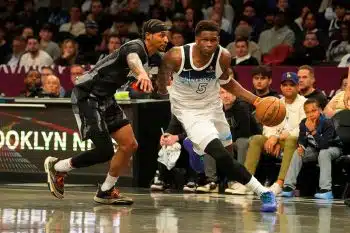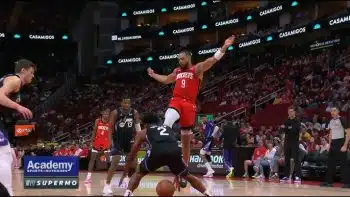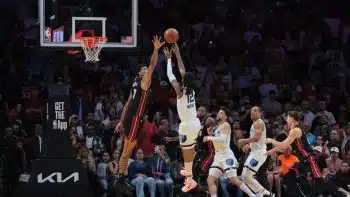NBA
Rest is More Than a Regular Season Consideration

The theme of planned, non-injury-related rest for aging or star players during the regular season has become somewhat prevalent in recent years. San Antonio’s Gregg Popovich (surprise, surprise) likely instigated the trend, one that started to gain real public traction over the last few seasons when several Spurs stars would suddenly show up as rest-related inactives for high-profile national games. It has yet to fully trickle into every team’s formula, but it’s certainly become more common to see coaches and front officers err on the side of caution and even allocate significant time off to guys who, by the traditional definition, aren’t “hurt.”
As it should, the arithmetic here changes come playoff time. Individual games that might have very little relevance in the regular season are nowhere to be found. Rotations tighten, with weak spots often eschewed completely due to the exploitative nature of the postseason; as a result, elite guys naturally spend more time on the floor. General effort level is increased across the board as well, with each given minute perhaps taking a slightly larger toll than the same 60 seconds in a mid-January game.
A prevailing narrative that accompanies the natural elevation in intensity, though, is the idea that minutes and the general burden on high-volume players are something close to irrelevant in the playoffs. This is a very narrow view. The issue is full of shades of grey, and the first few games of the 2015 postseason have given us several examples from varying ends of the spectrum with which to examine the context.
Before we delve into a couple, however, a qualifier: The NBA game today is vastly different from what it was even 10 years ago. The average player, even the average superstar, gets nowhere near the number of “plays off” on either end, particularly the defensive one where team-oriented schemes are the prevalent tactic for a game that’s moving further and further away from the isolation-heavy tendencies of decades past. There’s absolutely no question that today’s game is more physically demanding (to those shouting “hand-checks!” indignantly, meet “verticality” and the rise of strong-side overload defense, which make the game every bit as physical in the lane – if not more so), and the athletes are stronger and faster. The 2014-15 and 2013-14 seasons also ranked as the highest for league-average pace since 1993, meaning a given player sees more possessions for each minute on the court. For these reasons, historical comparisons to various legends who averaged some ungodly minute total on the way to a championship don’t hold much water in this conversation, even those in the not-so-distant past.
The name of the game is positive outcomes versus negative ones. The information regarding bodily stress and long-term effects therein is still quite incomplete even at the team level, and even more so as far as what’s confidently known in the public consciousness. One can only look to approximate the best set of decisions based on the limited information available. As far as minutes and general physical burden goes, this involves the question of upside against downside, often a multi-faceted beast.
Take the case of LeBron James, perhaps the poster boy for playoff overuse after his infamous fatigue-fueled failure in the 2011 Finals and multiple instances of cramping in pivotal playoff games. The Cavs and coach David Blatt were cognizant of LeBron’s load throughout the year, allowing him a two-week sabbatical of sorts and playing him the fewest minutes per game of his entire career when he did suit up. He even got a couple Spurs-ian “rest” games near the end of the year. This was the smart move.
It appears, however, that Blatt feels LeBron’s tank is topped off at this point. Game 1 of Cleveland’s matchup with Boston was of particular interest, and really helps illustrate the careful risk-reward balance at play with superstars of his ilk.
The Cavs led by eight coming out of halftime, with LeBron already sitting on just over 20 minutes of court time. Within his usual stretch of playing time to begin the third quarter, they stretched their advantage as far as the 20-point mark – the lead ebbed and flowed, but Cleveland spent over twice as much time in the second half of this game leading by 15 or more as it did with the margin under eight.
And yet, James remained on the court far longer than his typical substitution pattern. He’d normally sit in the first and third quarters with roughly four to six minutes remaining, but despite this being the exact period when Cleveland pushed their lead near 20, he didn’t rest. Blatt gave him a short respite with under two minutes to go in the third, but he was back to start the fourth and didn’t sit again until there were just 39 seconds remaining and the game was over.
Let’s look at the various upsides and downsides to this rotational pattern. The upside, of course, is that LeBron’s presence on the floor gives the Cavs a better chance at winning than anyone on the roster who’d replace him. But it’s important to view this as a matter of degrees rather than a concrete fact – the status of the game absolutely diminishes a great deal of this upside. So much time spent ahead by double figures would seem to be prime territory for a few extra minutes of rest with what’s assumed to be a long playoff run ahead, and would seem particularly so when considering that Cleveland outscored Boston by 10 points in just over six minutes LeBron spent on the bench in this game.
At this point, the downside starts to creep up quickly. We may not know by how much, sure, but it doesn’t take 10 years in medical school to understand that injury risk increases with more minutes, and that these things can compound over time. More importantly in this case, we have a player in LeBron with a specific, tangible history of overuse early in the playoffs keeping him from operating at full capacity when it matters most. Maybe the extra few minutes won’t make a difference… but maybe, when compounded with a few extra minutes in a few more games, they will. In a game, and a series, with such a low likelihood of defeat, do the positive outcomes really outweigh the negative ones?
As a simple contrast, look at someone like Anthony Davis. Davis is younger and has exponentially fewer miles on his odometer, but that’s not even what’s most important. He’s averaging 42 minutes of his own per game, but the context herein is almost the complete opposite: New Orleans, as a huge and overmatched underdog, has no periods of cushion, no 20-point leads to protect while Davis sits. They get crushed when he leaves the floor, and can’t even fully hold their own when he’s out there.
What’s more, the Pelicans have no delusions of a long playoff run. A win or two against the behemoth Warriors would be a huge victory, making concerns about cumulative buildup basically nonexistent. The upside to playing Davis huge minutes – the simple fact that it’s their only chance to hang with Golden State, plus the chance that he shows his true extra-terrestrial form and wins a game all by himself – far outweighs the downside, mostly just long-term injury which, again, we lack the capability to predict with any sort of certainty as far as minute totals go.
Never far from the spotlight, though, Clippers coach Doc Rivers gave us perhaps the most cut-and-dried example of how playoff intensity can quickly cross a line into totally unnecessary risk. Los Angeles roared out of the gate in Game 1 against San Antonio, playing with perhaps the highest level of cumulative fire seen from this core group in their years together. They dominated the Spurs, and put them away with a mid-fourth-quarter run that saw their lead reach 15 and never fall below it again for the final six and a half minutes of the game.
But with two minutes left and the Clippers up 17, there stood Chris Paul, Blake Griffin and DeAndre Jordan, all clearly exhausted but still running up and down the court. Doc had timeouts available and multiple convenient points at which to use them, but left his stars in for the entire remainder of the game.
Simply put, there is zero upside here. In LeBron’s case above, at least one could argue the game was never mathematically over – the most cynical of skeptics toward Cleveland’s supporting cast could, theoretically at least, suggest that LeBron’s absence would have had such a drastically negative effect that it would have been unwise to remove him for even a minute or two (these folks would be wrong, for reasons outlined earlier). For the Clippers, though, a point came well before the final buzzer where it was mathematically impossible for them to lose this game. At this point, there are no positive outcomes remaining to leaving a team’s most vital players on the floor for meaningless basketball.
On the flip side, the potential negative outcomes are many. The Clippers aren’t the Pelicans; they have realistic title aspirations, ones that will intensify exponentially should they defeat another Finals hopeful in the first round. They’re also incredibly top-heavy, with almost no depth and a bench that struggles miserably without one or more of their three stars to prop them up – these guys, then, need every available bit of juice. Neither Paul nor Griffin is exactly “injury-prone,” but neither has been the picture of perfect health in recent seasons either. What possible benefit could come from playing them several irrelevant minutes apiece when they’re already gassed?
If all of this seems like nitpicking, that’s because it is. The path to NBA glory is littered with the bones of teams and coaches who were unwilling or unable to recognize and adapt to important details, no matter how minute. Miami fans probably weren’t worried about a seemingly inhuman LeBron playing 44 minutes a game in the first three rounds in 2011, despite all three series going only five games and Miami winning several blowouts… until he was exhausted in the Finals, perhaps costing the team a title. No one is worried about overuse until Derrick Rose is on the floor in meaningless garbage time of a first-round game and comes down on his knee the wrong way, instigating one of the saddest sets of recurring injuries to a star player in league history.
Instances like these are exceptions, of course, and not rules. We never know when a freak incident might occur, and we’re still far from being able to accurately assess any sort of threshold for player usage and how it might affect a guy down the line. But why take the risk in situations when it’s completely unnecessary? One of the simplest tenets of game theory is the idea that any decision with zero positive outcomes and even a single negative one, no matter how unlikely or miniscule, is a bad decision.
As always, it’s a matter of surveying all the context involved. The circumstances surrounding Davis’ load don’t compare to those surrounding LeBron’s, which aren’t the same as those of the Clippers’ stars. Don’t be surprised if this is an issue we see rearing its head again before the postseason is out.











